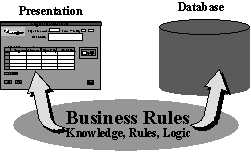|
Business rules automation starts off by
treating only non-trivial aspects of the system as business rules.
The information requirement of the company is captured in the data
model, with its related implicit business rules. The business logic
is fully captured in explicit business rules that are declared on
top of this data model.
When the generated user
interface needs to be adapted, this is defined in terms of
presentation rules in the final stage of the development process.
Trivial application components, like querying facilities, and all
data manipulation requirements, are generated automatically.
As a result, the data model,
the rules that capture the business logic and the user interface
are all captured in the repository. Together they are called the
business model; this actually constitutes the system. In practice,
various applications can be derived automatically from this
repository-based system definition. Business rules are no longer
hidden away in low-level application code, stored procedures,
scripting languages, and so on. They are stored and managed in an
open model-based environment.

Three Tiers Orchestrated by a Rules
Engine
|

